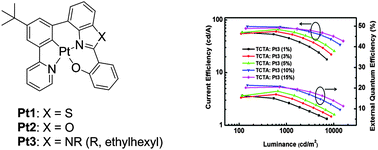Strongly phosphorescent platinum(ii) complexes supported by tetradentate benzazole-containing ligands†
Abstract
A series of strongly phosphorescent Pt(II) complexes (Pt1–Pt3) supported by rigid benzazole-containing tetradentate ligands (L1–L3) were designed and synthesized. The effect of heteroatoms (S, O and N) on the photophysical and electroluminescence properties of Pt(II) complexes was studied systematically. Complex Pt1 based on the benzothiazole-containing ligand exhibited a red-shift in UV-vis and photoluminescence spectra in comparison with Pt2 and Pt3 due to the low electro-negativity and high polarizability of the S atom. Organic light-emitting diodes (OLEDs) with various doping levels of these Pt(II) phosphors were fabricated. At low complex concentration, Pt1, Pt2 and Pt3 mainly showed high energy monomer emission. When the doping ratio was increased, low energy excimer emission was observed for both Pt1 and Pt2. On the contrary, Pt3 dominantly showed monomer emission even at a high doping level because the strong intermolecular interactions were greatly suppressed due to the presence of bulky alkyl chains as revealed by X-ray crystallographic analysis. OLEDs based on these complexes exhibited yellowish green to greenish yellow electro-phosphorescence with high efficiency. Notably, the device based on Pt3 at the doping level of 10 wt% achieved a maximum efficiency of 75.0 cd A−1, 70.1 lm W−1 and 21.4% with Commission Internationale de L'Eclairage (CIE) coordinates of (0.33, 0.61).


 Please wait while we load your content...
Please wait while we load your content...